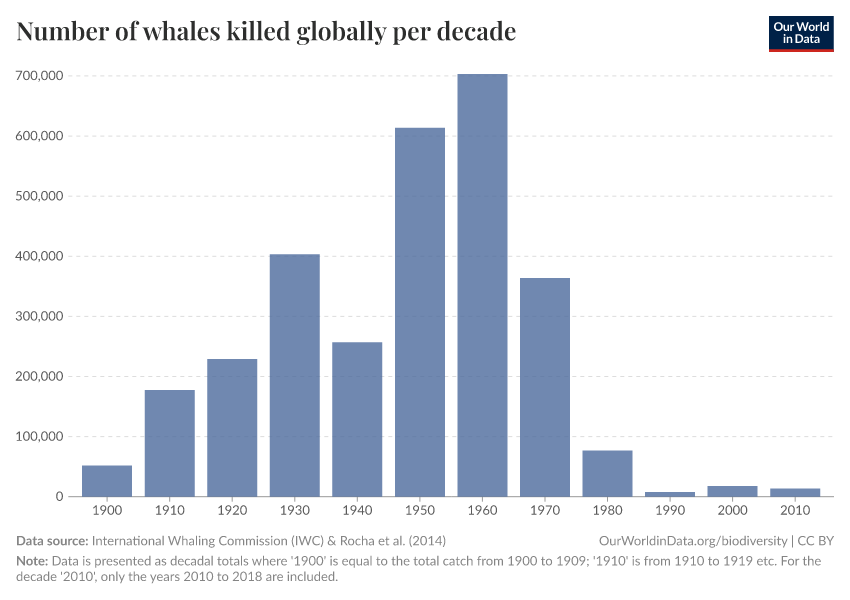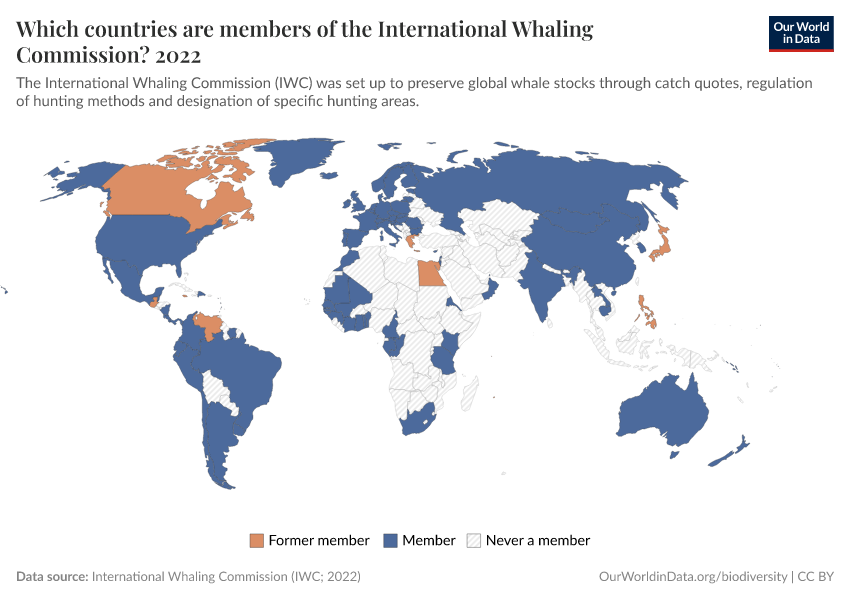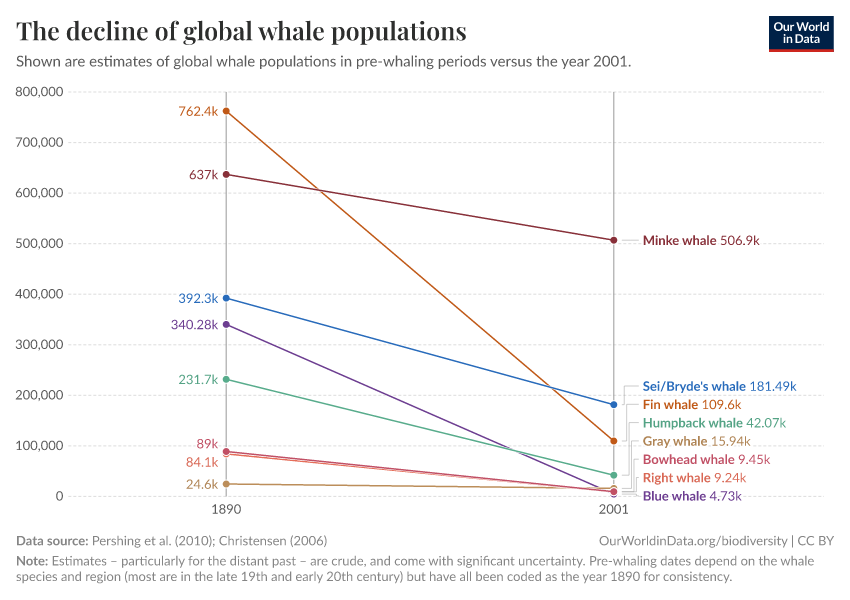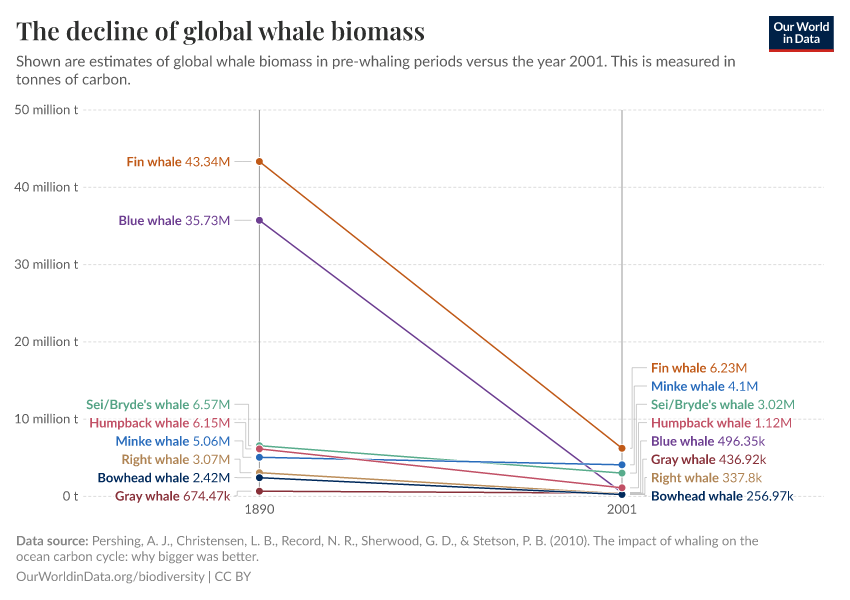Global whaling peaked in the 1960s
Intense whaling drove many of the world’s whale species close to extinction. But a dramatic decline in whale hunting since then has given them hopes of recovery.
Weighing in at over 150 tonnes, Blue Whales are the largest animal to have lived on Earth. But their size hasn’t protected them from human exploitation. In fact, their size made them an incredibly valuable source of oil, meat and blubber. This fat gave us a rich fuel for energy and many other industrial uses.
Human hunting has resulted in a massive decline in global whale populations. Some have been pushed to the brink of extinction. But, as we will see, a combination of technological change, economic incentives and international policies have brought global whaling to very low levels. While some populations are still very small, we have been successful in preserving these beautiful animals.
Early whaling in the United States
Whaling is a practice that dates back to Medieval times; fortunately at low levels, meaning this early practice had little impact on whale populations.1
While global whaling was a feature of the 1900s, the peak of whaling in the United States was a century earlier. In the 18th and 19th centuries, whaling was a key industry in the US.
Although the uses of whale oil later diversified, Americans mainly used it for lighting. Whale oil was used for the lighting of not only homes but also outdoor street lighting, lighthouses and miner’s headlamps – a range of uses that had a big impact on civilization during that period.2
As we see in the chart, US production of whale and sperm oil followed the classic inverted-U curve, peaking in the mid-19th century. At this point, petroleum oil had been discovered, and kerosene – which was cheaper than whale oil – began to replace it in lighting. As whale hunting became increasingly unprofitable, production soon declined.3
Modern whaling reduced Blue Whale populations by 98.5%
While the United States dominated whaling during the 19th century, it didn’t really reach the global stage until the 20th century.
Towards the end of the 1800s, new technologies were being developed that could catch whales in much larger numbers. Rather than the classic sail- or oar-powered boats that the Americans had been using, the Norwegians developed mechanized, steam-powered vessels with cannons and harpoons. This made whaling much more efficient. Not only could we catch more whales, it also allowed us to catch species – like Blue and Fin Whales – that were too fast for our old technologies.
This marked the start of the ‘modern’ whaling era, from around 1890 onwards. It had a dramatic impact.
Not all species were impacted equally by whaling. Some of the largest – the Blue and Fin Whale in particular – were prime targets. This meant that the decline of the biomass of whales over this period was even greater.
We see this discrimination towards particular species in the chart. All species declined, but the extent was wildly different. The Minke Whale saw a fall of just 20%.4 The Blue Whale was almost plundered into extinction. Its populations fell from 340,000 to just 5,000. A reduction of 98.5%.5 The Fin Whale lost 85% of its numbers.6
The rise and fall of whaling
The 20th century didn’t only bring technological innovations on how to track and hunt whales, it also brought advances in how we could use the oils, blubber, and bone that they provided. Both demand and supply rocketed.
Whale oils were initially used for lighting, but their market soon expanded. Sperm oil is special because it maintains its lubricating qualities at very high temperatures – this made it a vital ingredient for machinery, engines, guns and watches during the Industrial Revolution. Advancements in cosmetics and food chemistry meant that its by-products were soon used for soaps, textiles, and even margarine.
Ambergris – a substance found in the intestine of sperm whales – was, and still is, used to make perfume. You will find it in the luxury perfume, Chanel No.5. Whales made it into the fashion industry too. Instead of teeth, baleen whales have long strips of keratin (the substance found in human nails and hair) which hang from their mouths – these plates were used in everything from skirts and women’s corsets, to umbrellas, parasols, fishing poles and crossbows.7
In the chart, we see how this rising demand for whale products affected hunting rates across the world. This shows the number of whales killed each year, from 1900 onwards.
For decades, tens of thousands of whales were killed each year. Only World War II gave these animals some reprieve – notice the drop in kills during the early-1940s.
At its peak in the 1960s, we were hunting 80,000 whales every year.
It didn’t go unnoticed that this rate of whale catch was unsustainable. In fact, a number of countries formed the International Whaling Commission (IWC) in 1946 to work out how to manage international whaling stocks. Quotas were introduced, but countries weren’t adhering to them.8 Whaling rates continued to rise, even after the lull of World War II. By the mid-20th century, many species were pushed to the brink of extinction.

Whaling peaked in the 1960s – how did the world tackle this?
By the mid-20th century, the prospects for whales was looking bleak. And yet, the world managed to turn things around.
In the chart we see the number of whales killed per decade.
We see a gradual rise over the first half of the century – with the exception of the war-stricken 1940s – with whale catch reaching its peak in the 1960s. 703,000 whales were killed during the 1960s.
But, we've seen a decline since then. What caused this?
There were a number of factors at play. By the 1960s, whale populations had become increasingly depleted – this scarcity had an impact on the economic incentives to hunt them. Whales were becoming harder to find and catch. Technological advances also meant that substitutes for whale oil and bone in the cosmetic, food, and textile industries were becoming cheaper and more accessible. The whaling industry was losing its profitability.
There was another massive policy change in the 1980s. More and more countries were becoming members of the International Whaling Commission.
In the map, we see the timeline by which countries joined the IWC.
After many decades of failed quota agreements, the IWC agreed to a global moratorium. This made commercial whaling illegal, with only a few exceptions.9 This came into action in 1987, and we see a dramatic drop-off in whale catch in the decades since then.
You will notice that we haven’t eliminated whaling completely. Some countries – such as Japan, Norway and Iceland – have resumed limited whaling outside the guidelines of the IWC.9 In 2019, Japan withdrew from the international agreement. These countries typically hunt species that are not considered to be critically endangered.
Some species will still take many decades to recover. Populations of North Atlantic right whale, the Arctic bowhead, and the Pacific blue whale are still critical.
Yet the story of whaling overall is a conservation success: an animal that was once in high demand across the world has been saved from extinction through substitution and international cooperation. Many species are in a similar position to whales in the 1960s. But the decline of whaling should give us hope that we can turn things around once again.


Endnotes
Birnie, P. W. (1989). International legal issues in the management and protection of the whale: a review of four decades of experience. Natural Resources Journal, 29(4), 903-934.
Starbuck, A., 1878, (reprinted 1989), History of the American whale fishery: Secaucus, NJ., Castle.
Coleman, J. L. (1995). The American whale oil industry: A look back to the future of the American petroleum industry?. Nonrenewable Resources, 4(3), 273-288.
We can calculate this as: [(637,000 - 507,000) / 637,000 = 20%].
We can calculate this as: [(340,000 - 5,000) / 340,000 = 98.5%].
We can calculate this as: [(762,000 - 110,000) / 762,000 = 85%].
Tønnessen, J.N. and Johnsen, A.O. The history of modern whaling. University of California Press, Berkeley.
Clapham , P.J. and B aker, C.S. (2002). Modern whaling. In: Perrin , W.F., Würsig, B. & T hewissen, J.G .M. (eds.), Encyclopedia of Marine Mammals, pp. 1328-1332. Academic Press, New York.
The moratorium only applies to commercial whaling, so whaling classified for scientific research purposes and aboriginal-subsistence provisions is still allowed.
Cite this work
Our articles and data visualizations rely on work from many different people and organizations. When citing this article, please also cite the underlying data sources. This article can be cited as:
Hannah Ritchie (2022) - “Global whaling peaked in the 1960s” Published online at OurWorldinData.org. Retrieved from: 'https://archive.ourworldindata.org/20251125-173858/whaling.html' [Online Resource] (archived on November 25, 2025).BibTeX citation
@article{owid-whaling,
author = {Hannah Ritchie},
title = {Global whaling peaked in the 1960s},
journal = {Our World in Data},
year = {2022},
note = {https://archive.ourworldindata.org/20251125-173858/whaling.html}
}Reuse this work freely
All visualizations, data, and code produced by Our World in Data are completely open access under the Creative Commons BY license. You have the permission to use, distribute, and reproduce these in any medium, provided the source and authors are credited.
The data produced by third parties and made available by Our World in Data is subject to the license terms from the original third-party authors. We will always indicate the original source of the data in our documentation, so you should always check the license of any such third-party data before use and redistribution.
All of our charts can be embedded in any site.

